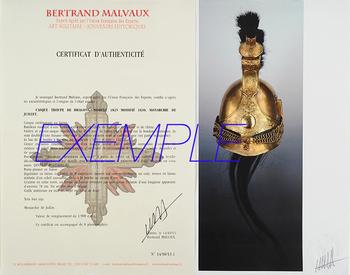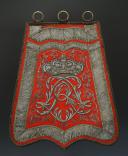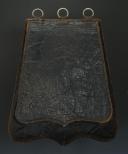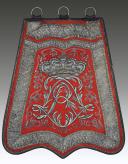
SABRETACHE D'OFFICIER DE HUSSARDS DU RÉGIMENT DE BERCHENY, MODÈLE 1767, ANCIENNE MONARCHIE, RÈGNE DE LOUIS XVI.
BERCHENY REGIMENT HUSSAR OFFICER'S SABRETACHE, MODEL 1767, FORMER MONARCHY, REIGN OF LOUIS XVI. 12576
Trapezoidal black waxed leather strap cut in the shape of an accolade in the lower part, covered with a scarlet cloth richly decorated with embroidery and silver braid, H 39 cm, width in the upper part 22 cm, width in the lower part 34cm.
In the center of the pattelette, are embroidered, in threads, cannetilles and silver sequins, two intertwined “L”s facing each other, H 14 cm, width 17.5 cm; they are surmounted by a large royal crown richly embroidered in threads, purls, sequins and silver lamé, H 7 cm, width 13.3 cm. These two motifs are surrounded by a floral decoration using silver threads and sequins. The tab is framed by a wide silver braid woven with a geometric pattern, width 4 cm, sewn 5 mm from the outer edge of the tab.
In the upper part, this braid is lined with a second braid of the same pattern but less wide, 2.2 cm. Outer edges of the placket trimmed with a saddle-folded leather band sewn with silver thread. Three suspension rings are fixed at the top (reconstituted).
Inside pocket in black waxed leather fully lined with white calfskin, H 31.2 cm, width at the top 20.5 cm, width at the bottom 27.5 cm.
Very good state of preservation, the sheet has kept its original color, the braids and trimmings are slightly oxidized.
France.
Former Monarchy, 1786-1789.
COLLECTIBLES:
To my knowledge, only two copies of this model have come down to us. The one presented here and an identical copy, of the same manufacture, with a slightly less rich embroidery, part of the collections of the Museum of the Hussars of the city of Tarbes.
HISTORY:
Founded in part from Hussars raised in Turkey by Count Ladislas-Ignace de Bercheny. Hungarian patriot, born on August 3, 1689, after having taken part in the campaigns of 1708, 1709 and 1710, as cornet then as captain of the Noble Guards of prince Rakoczy, in fight against his sovereign Emperor King, Charles III (Emperor of Germany under the name of Charles VI) which ends with the victory of the sovereign, Bercheny goes to France in 1712, proscribed by the Habsburgs, where he begins a brilliant military career that will make him a Marshal of France. Musketeer in the 1st company, on September 1, 1712, he received on December 31 a commission of reformed lieutenant-colonel (that is to say on reduced pay) following Rattsky Hussars. He distinguished himself during the campaign against Spain in 1719 and received the cross of Saint-Louis. When peace returned, Bercheny asked the King for permission to raise a regiment of hussars made up of Hungarian refugees in Turkey. On June 12, 1720, Louis XV granted this authorization and made Bercheny the first corps commander of the new regiment.
Armed with his powers and letters patent and credit, Bercheny left on horseback across Germany for Constantinople, accompanied by two captains and three lieutenants. Upon arrival, after having received the approval of the French Ambassador and the Grand Vizier Ibrahim Pasha, the recruiting mission set to work. The situation of Hungarian political refugees is precarious in Turkey, the Ottoman population is not hostile, but the Turks do not want to hire Catholics. Bercheny had no trouble engaging three hundred men. The contingent embarked on Genoese galleys and landed near Montpellier. The funds provided for the establishment of the regiment being exhausted, the remount cannot be assured. Initially the regiment served as a sanitary cordon in the Cévennes against the plague. The Duke of Orlénant, Regent of the Kingdom, grants the necessary credits for the purchase of horses. The regiment finally on horseback is directed to Alsace.
Such are the beginnings of the body of the regiment of Bercheny Hussars, one of the most prestigious of the French army, which will continue to cover itself with glory until our days. We are far from the legend spread by Abbé Staub, chaplain to the hussars under the Second Empire, recounting that Lasdislas Bercheny, at the age of twenty-one, left Hungary at the head of his regiment of hussars, gloriously crossing Germany, arriving in France, and immediately went to Versailles to put his sword and that of his men at the disposal of the King of France…
The founder of the first regiment of hussars became brigadier of the king's armies on February 20, 1734, maréchal-de-camp on March 1, 1738 and lieutenant-general on June 7, 1744, elevated to the dignity of Marshal of France on March 15, 1758. He died on January 9, 1778 at the age of 88, his body resting in the church of Luzancy (Seine-et-Marne), near his castle.
In 1791 it became the 1st Regiment of Hussars.
Today the 1st Parachute Hussar Regiment fulfills all the missions of a light cavalry regiment: reconnaissance in contact or in depth, anti-tank intervention, rear or flank security. Its equipment can be air-dropped, airborne or transported by any other means of transport.
ORIGIN OF THE SABRETACHE:
It is difficult to determine the exact origin of the sabretache. Two things are certain: it comes from the East and its primary use by light riders is practical; it is intended to carry some personal effects. When the Hussars entered the service of France at the end of the 17th century, they brought with them this equipment which would remain the most traditional and the most specific of this corps until the end of the Second Empire. During the 18th and 19th centuries, the sabretache became traditional equipment for certain cavalry troops, but given the size of the inside pocket of this equipment, one cannot speak of a "utilitarian object": the troops can at most store a few documents or tobacco there, as for the officers, they do the same, but some prefer to install their toiletries there.
Trapezoidal black waxed leather strap cut in the shape of an accolade in the lower part, covered with a scarlet cloth richly decorated with embroidery and silver braid, H 39 cm, width in the upper part 22 cm, width in the lower part 34cm.
In the center of the pattelette, are embroidered, in threads, cannetilles and silver sequins, two intertwined “L”s facing each other, H 14 cm, width 17.5 cm; they are surmounted by a large royal crown richly embroidered in threads, purls, sequins and silver lamé, H 7 cm, width 13.3 cm. These two motifs are surrounded by a floral decoration using silver threads and sequins. The tab is framed by a wide silver braid woven with a geometric pattern, width 4 cm, sewn 5 mm from the outer edge of the tab.
In the upper part, this braid is lined with a second braid of the same pattern but less wide, 2.2 cm. Outer edges of the placket trimmed with a saddle-folded leather band sewn with silver thread. Three suspension rings are fixed at the top (reconstituted).
Inside pocket in black waxed leather fully lined with white calfskin, H 31.2 cm, width at the top 20.5 cm, width at the bottom 27.5 cm.
Very good state of preservation, the sheet has kept its original color, the braids and trimmings are slightly oxidized.
France.
Former Monarchy, 1786-1789.
COLLECTIBLES:
To my knowledge, only two copies of this model have come down to us. The one presented here and an identical copy, of the same manufacture, with a slightly less rich embroidery, part of the collections of the Museum of the Hussars of the city of Tarbes.
HISTORY:
Founded in part from Hussars raised in Turkey by Count Ladislas-Ignace de Bercheny. Hungarian patriot, born on August 3, 1689, after having taken part in the campaigns of 1708, 1709 and 1710, as cornet then as captain of the Noble Guards of prince Rakoczy, in fight against his sovereign Emperor King, Charles III (Emperor of Germany under the name of Charles VI) which ends with the victory of the sovereign, Bercheny goes to France in 1712, proscribed by the Habsburgs, where he begins a brilliant military career that will make him a Marshal of France. Musketeer in the 1st company, on September 1, 1712, he received on December 31 a commission of reformed lieutenant-colonel (that is to say on reduced pay) following Rattsky Hussars. He distinguished himself during the campaign against Spain in 1719 and received the cross of Saint-Louis. When peace returned, Bercheny asked the King for permission to raise a regiment of hussars made up of Hungarian refugees in Turkey. On June 12, 1720, Louis XV granted this authorization and made Bercheny the first corps commander of the new regiment.
Armed with his powers and letters patent and credit, Bercheny left on horseback across Germany for Constantinople, accompanied by two captains and three lieutenants. Upon arrival, after having received the approval of the French Ambassador and the Grand Vizier Ibrahim Pasha, the recruiting mission set to work. The situation of Hungarian political refugees is precarious in Turkey, the Ottoman population is not hostile, but the Turks do not want to hire Catholics. Bercheny had no trouble engaging three hundred men. The contingent embarked on Genoese galleys and landed near Montpellier. The funds provided for the establishment of the regiment being exhausted, the remount cannot be assured. Initially the regiment served as a sanitary cordon in the Cévennes against the plague. The Duke of Orlénant, Regent of the Kingdom, grants the necessary credits for the purchase of horses. The regiment finally on horseback is directed to Alsace.
Such are the beginnings of the body of the regiment of Bercheny Hussars, one of the most prestigious of the French army, which will continue to cover itself with glory until our days. We are far from the legend spread by Abbé Staub, chaplain to the hussars under the Second Empire, recounting that Lasdislas Bercheny, at the age of twenty-one, left Hungary at the head of his regiment of hussars, gloriously crossing Germany, arriving in France, and immediately went to Versailles to put his sword and that of his men at the disposal of the King of France…
The founder of the first regiment of hussars became brigadier of the king's armies on February 20, 1734, maréchal-de-camp on March 1, 1738 and lieutenant-general on June 7, 1744, elevated to the dignity of Marshal of France on March 15, 1758. He died on January 9, 1778 at the age of 88, his body resting in the church of Luzancy (Seine-et-Marne), near his castle.
In 1791 it became the 1st Regiment of Hussars.
Today the 1st Parachute Hussar Regiment fulfills all the missions of a light cavalry regiment: reconnaissance in contact or in depth, anti-tank intervention, rear or flank security. Its equipment can be air-dropped, airborne or transported by any other means of transport.
ORIGIN OF THE SABRETACHE:
It is difficult to determine the exact origin of the sabretache. Two things are certain: it comes from the East and its primary use by light riders is practical; it is intended to carry some personal effects. When the Hussars entered the service of France at the end of the 17th century, they brought with them this equipment which would remain the most traditional and the most specific of this corps until the end of the Second Empire. During the 18th and 19th centuries, the sabretache became traditional equipment for certain cavalry troops, but given the size of the inside pocket of this equipment, one cannot speak of a "utilitarian object": the troops can at most store a few documents or tobacco there, as for the officers, they do the same, but some prefer to install their toiletries there.
Price :
24 000,00 €
| Destination | Envoi recommandé | Envoi Recommandé + Express |
|---|---|---|
| Shipping France | 17,00 € | 50,00 € |
| Shipping Europe | 24,00 € | 70,00 € |
| Shipping world | 68,00 € | 120,00 € |
Insurance (1%) :
240,00 €
Reference :
12576

Next update Friday, december 26 at 13:30 PM
FOR ALL PURCHASES, PAYMENT IN MULTIPLE CHECKS POSSIBLE
bertrand.malvaux@wanadoo.fr 06 07 75 74 63
SHIPPING COSTS
Shipping costs are calculated only once per order for one or more items, all shipments are sent via registered mail, as this is the only way to have proof of dispatch and receipt.
For parcels whose value cannot be insured by the Post, shipments are entrusted to DHL or Fedex with real value insured, the service is of high quality but the cost is higher.
RETURN POLICY
Items can be returned within 8 days of receipt. They must be returned by registered mail at the sender's expense, in their original packaging, and in their original condition.
AUTHENTICITY
The selection of items offered on this site allows me to guarantee the authenticity of each piece described here, all items offered are guaranteed to be period and authentic, unless otherwise noted or restricted in the description.
An authenticity certificate of the item including the description published on the site, the period, the sale price, accompanied by one or more color photographs is automatically provided for any item priced over 130 euros. Below this price, each certificate is charged 5 euros.
Only items sold by me are subject to an authenticity certificate, I do not provide any expert reports for items sold by third parties (colleagues or collectors).
FOR ALL PURCHASES, PAYMENT IN MULTIPLE CHECKS POSSIBLE
bertrand.malvaux@wanadoo.fr 06 07 75 74 63
An authenticity certificate of the item including the description published on the site, the period, the sale price, accompanied by one or more color photographs is automatically provided for any item priced over 130 euros. Below this price, each certificate is charged 5 euros.
Only items sold by me are subject to an authenticity certificate, I do not provide any expert reports for items sold by third parties (colleagues or collectors).






